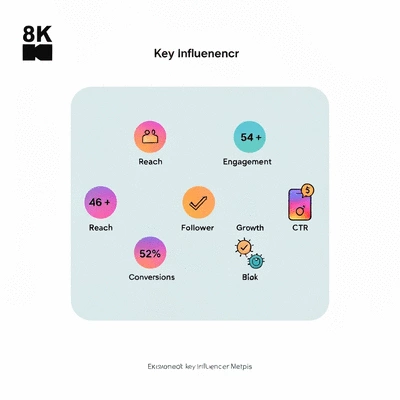Reach & Impressions
How many people see your content and how often. Crucial for brand visibility.

In the rapidly evolving realm of social media, understanding how influencers grow and engage their audiences is more valuable than ever. What if you could unlock the secrets to building authentic connections that translate into brand loyalty and sales? This article dives deep into the metrics that define influencer growth and the strategies for cultivating meaningful engagement.
This visual outlines the essential metrics that guide effective influencer strategies and audience interaction.
How many people see your content and how often. Crucial for brand visibility.
Measures interactions (likes, comments, shares) relative to audience size. Indicates content resonance.
Tracks audience expansion over time, showing trends in new followers and brand reach.
Measures how often viewers click on calls to action. Essential for measuring direct response.
Determines how many audience interactions lead to desired actions, such as purchases or sign-ups.
In today’s digital landscape, the concept of influencer growth is more crucial than ever. As social media continues to evolve, understanding what drives this growth can unlock opportunities for brands and creators alike. Influencer growth is not just about the number of followers; it's about the ability to engage these audiences authentically and meaningfully. This engagement can lead to significant brand loyalty and sales.
Moreover, the very nature of audience engagement has transformed. It's not just about likes and shares anymore; it's about creating a community around your brand. This requires a deeper exploration of how influencers interact with their audiences and the strategies they employ to foster those connections. Let's dive into the key aspects of influencer growth and how they relate to audience engagement.

When we talk about influencer growth, we often refer to several metrics that signify a creator's effectiveness. This includes:
Each of these factors plays a vital role in shaping an influencer's digital footprint. At Likers Network, I’ve seen how understanding these metrics can empower both influencers and brands to make data-driven decisions that enhance their online presence. For a comprehensive overview of current trends and statistics in the field, explore the 2023 State of Influencer Marketing Report by Linqia, which further elaborates on the importance of these metrics.
Engagement is the lifeblood of any successful digital marketing strategy. Brands that effectively engage their audiences are more likely to see positive outcomes, such as increased sales and brand loyalty. Here are some reasons why engagement matters:
At Likers Network, we emphasize the significance of cultivating genuine relationships over simply chasing numbers. By focusing on engagement, brands can create lasting connections that translate into loyalty and advocacy. To deepen your understanding of how influencer marketing drives engagement and builds trust, consider reviewing this research on the impact of influencer marketing on consumer trust and purchase intention.
To maximize audience engagement, understanding demographics is essential. Different age groups, interests, and locations can influence how content is received. Here are some key demographic factors to consider:
By analyzing these demographics, brands can tailor their strategies to better connect with their target audiences. It’s all about creating content that speaks directly to them, enhancing both engagement and influencer growth. For more insights on how to measure and optimize these efforts, check out Sprout Social's guide to influencer marketing metrics.
To truly enhance your audience engagement, consider leveraging the power of storytelling in your content. Sharing authentic stories or experiences not only captures attention but also fosters a deeper connection with your audience. Remember, people relate to real experiences — it’s what turns casual followers into loyal advocates for your brand!
Influencer growth refers to the expansion of a creator's digital footprint, encompassing increased follower count, improved engagement rates, broader content reach, and more brand partnerships. It signifies a creator's effectiveness in reaching and impacting their audience.
Audience engagement is vital because it builds trust between influencers and their followers, boosts content visibility through social media algorithms, and increases the likelihood of converting followers into loyal customers. It helps create lasting connections and advocacy for a brand.
Key demographic factors include age, location, and interests. Understanding these helps tailor content to resonate with specific audience segments. Younger audiences may prefer different styles, cultural differences can influence message reception, and specific interests can significantly boost engagement.
The essential metrics for tracking influencer success include Reach and Impressions (how many people see content), Engagement Rate (interactions relative to audience size), Follower Growth (audience expansion over time), Click-Through Rate (CTR) (how often calls to action are clicked), and Conversions (audience actions leading to desired outcomes like purchases).
To effectively track and adapt your strategy, you should define clear goals, select metrics that align with those goals, utilize analytics tools (like Google Analytics or social media insights), and regularly monitor and adjust your strategies based on the data collected. This ensures your content remains relevant and impactful.
As we wrap up our discussion on influencer metrics, it’s crucial to highlight the essential metrics that can guide your growth and engagement strategies. These metrics not only offer insights into your performance but also help align your content with audience expectations. Here’s a quick recap of the key metrics we’ve explored:
These metrics form the foundation of a successful influencer marketing strategy. By focusing on them, you can not only track growth but also enhance your overall engagement.

In the fast-paced world of digital marketing, staying on top of your engagement metrics is vital. Regularly reviewing these metrics can provide a clearer picture of your audience's preferences and needs. This approach allows you to pivot your strategy when necessary, ensuring that your content remains relevant and impactful. Remember, it's not just about the numbers; it's about understanding the story behind those numbers.
At Likers Network, we understand that engagement isn't a one-time effort. It requires continuous analysis and adaptation. Are you currently tracking your influencer metrics? If not, consider implementing a system to start measuring today. The insights you gain could transform your approach to content creation and audience interaction!
So, where do you go from here? Implementing the right metrics into your strategy starts with identifying your key objectives. Here are some steps you can take:
By systematically implementing these steps, you can enhance your understanding of your influencer impact.
Your insights matter! Have you tried tracking your influencer metrics? What challenges have you faced? I invite you to join the conversation and share your experiences. At Likers Network, we’re committed to fostering a community where knowledge is shared and growth is collective. Let’s learn from one another as we navigate the exciting landscape of influencer marketing!
Here is a quick recap of the important points discussed in the article:
Gaming Communities and Digital Culture

Have you ever stopped to consider how gaming communities shape not just individual players, but enti
Gaming Communities and Digital Culture
Social Media Growth Tactics
Social Media Trends to Watch
Grow Your Audience with Hashtags
Smart Glasses and Urban Living